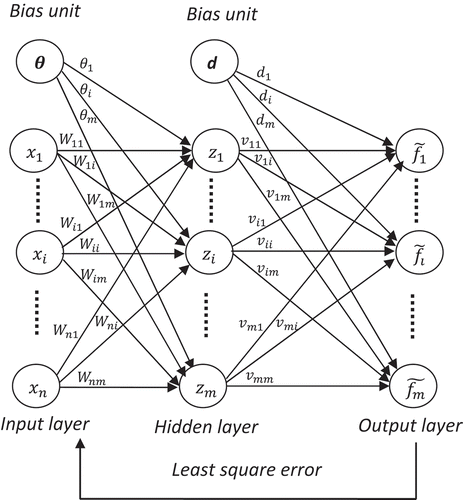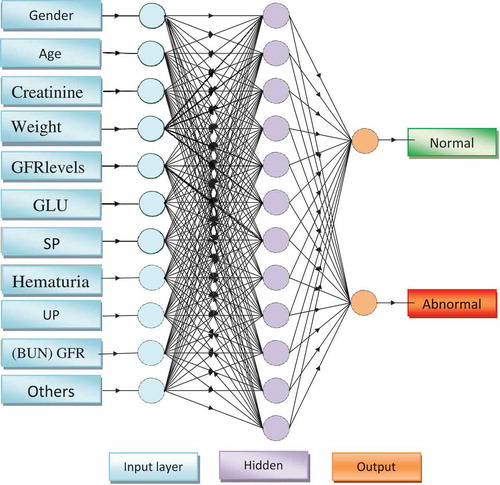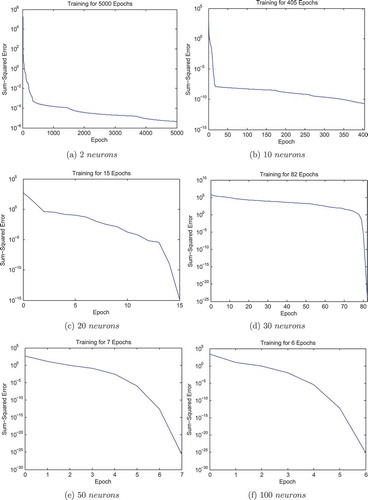 ?Mathematical formulae have been encoded as MathML and are displayed in this HTML version using MathJax in order to improve their display. Uncheck the box to turn MathJax off. This feature requires Javascript. Click on a formula to zoom.
?Mathematical formulae have been encoded as MathML and are displayed in this HTML version using MathJax in order to improve their display. Uncheck the box to turn MathJax off. This feature requires Javascript. Click on a formula to zoom.Abstract
In this paper, we introduce a new diagnosing technique for chronic kidney disease by using Artificial Neural Network (ANN). Where, the required data for the computational health-care system is collected from various hospitals at Jazan region, Saudi Arabia. Furthermore, in order to prove the convergence of this method, a ridge function is used in the hidden layer as a basis for the neurons. The technique applied for different number of neurons, and in each case a least square error is provided for choosing the best possible approximation.
Public Interest Statement
The Chronic Kidney Diseases (CKD) have become a major public health problem in Saudi Arabia, and particularly in the province of Jazan due to many factors that contributed to outbreaks of this disease. Therefore, this article proposes intelligent model developed for the early detection of chronic kidney disease based on the method of artificial neural networks that have been proven to be effective with high accuracy. The model can be used for a self-diagnosis by entering the person’s data to get the results which helps and improve the public health care.
1. Introduction
In the last few decades, the advances in the computational tools and in the field of artificial intelligence have led to design expert systems which are used for making better decisions in various areas of life (Almási et al., Citation2016; Karlik & Olgac, Citation2011). And medical application is one of the fertile areas for this type of systems (Bardram, Baldus, & Favela, Citation2006; Canan, Oguz, & Haluk, Citation2011; Cosenza, Citation2012; Karlik & Olgac, Citation2011). Where multi-layer Artificial Neural Network is considered as a reliable auxiliary tool for diagnosing common diseases with better accuracy (Arista-Jalife & Arista-Viveros, Citation2011; Canan et al., Citation2011; Kabari & Bakpo, Citation2009; Karan, Bayraktar, Gumuskaya, & Karlik, Citation2012; Karlik & Öztoprak, Citation2007; West & West, Citation2000). On the other hand, the Chronic Kidney Diseases (CKD) have become a major public health problem in Saudi Arabia, and particularly in the province of Jazan due to many factors that contributed to outbreaks of this disease (Al-Sayyari & Shaheen, Citation2011). Therefore, the need of constructing such intelligent systems to reduce the spread of this chronic disease and propose practical solutions for early diagnosis.
The authors in (Arista-Jalife & Arista-Viveros, Citation2011) implemented multi-layer back propagation artificial neural networks coupled with self-organizing map for diagnosing some common diseases up to of accuracy under certain conditions of truncate information input. B. Canan et al. (Canan et al., Citation2011) developed a client-server system to diagnose internal illnesses by using pervasive health-care computing and Artificial Neural Networks (ANNs). Next, a framework for diagnosing skin diseases using artificial neural networks presented in (Kabari & Bakpo, Citation2009) where the proposed system reached
of success. L. G. Kabari, F. S. Bakpo (Karan et al., Citation2012) present a novel approach for diagnosing diabetes using neural network computations to develop a mobile software service for pervasive healthcare.
In this paper, we will present a new mathematical model for diagnosing kidney failure disease by mean of artificial neural networks. The model is constructed by taking samples from Jazan hospitals (positive samples and negative samples) to train the system and then test it on different samples. Moreover, the proposed model is supported by the mathematical theory that shows the convergence of the results. It is organized as follows: In Section 2 we give an indicator of the CKD and classification. In Section 3 we present the neural network model for diagnosing kidney failure. Section 4 is devoted to data training and the numerical results. Finally, we conclude and describe future work in Section 5.
2. Indicator of the CKD and classification
According to the medical treatment of CKD, the Glomerular Filtration Rate (GFR) is the most indicator used to estimate kidney health function. Which can be computed from the patient’s blood creatinine, age, race, gender, and other factors depending on the used formulas (Chiu, Chen, Wang, Chang, & Chen, Citation2013; Levey, DeJong, & Coresh et al., Citation2011; Matsushita, Mahmoodi, & Woodward et al., Citation2012). However, the commonly used formula is the Modification of Diet in Renal Disease (MDRD) (Matsushita et al., Citation2012)
where for a female, the result should be multiplied by a factor of 0.742.
Moreover, the classification of CKD defined by the foundation’s Kidney Disease Outcomes Quality Initiative (KDOQI) (National Kidney Foundation (NKF), Citation2002), is shown in Table .
Table 1. Classification of CKD defined by KDOQI
3. Neural Network model for diagnosing kidney failure
The artificial neural network (ANN) is a mathematical computational method that is used in different areas of science such as: approximation of functions, numerical solutions for PDEs and ODEs, speech recognition, videos games, medical diagnosis, and in many other domains (Almarashi, Citation2012; Almarashi & Al-Wagih, Citation2007; Almarashi, Mechai, & Alghamedi, Citation2015). In the literature, there are many different types of neural network models, however, in this paper, the study is limited to the Back-Propagation Neural Network (BPNN) method with Ridge basis functions as illustrated in Figures and .
The following theorem gives the sufficient conditions for the convergence of the Neural network method (Almarashi et al., Citation2015).
Theorem 1. Let be a ridge basis function, nonconstant, bounded, and monotone increasing continuous function. Let
be a compact subset on
, and
a real value continuous function on
Then for any arbitrary
, there exist integer
and real constants
for
and
such that
satisfies
In other words, for any arbitrary there exists a three-layer network: where the hidden layer represented by the ridge basis function
which has an input-output function
such that
4. Training data for kidney failure
The proposed model for diagnosing kidney failure consists of using one input layer, one hidden layer, and one output layer as presented in Figure . Where the input vector has dimension 11 and the output vector has dimension 2. Furthermore, the input data names and their units are shown in Table , Table , Table and the outputs will be NORMAL and ABNORMAL. The input data set was collected from different government and private hospitals in Jazan region KSA, and 1150 patients’ cases were used for the training data selected from 1576 observations. The first 520 samples are negative, while 630 are positive (see Table ).
Table 2. Training data for kidney failure
Table 3. The influence factors in the GFR formula
Table 4. Neural network influence factors for CKD detection
Table 5. Data distribution for model training, testing, and cross verification
First, the system was trained for positive and negative samples with different numbers of neurons in the hidden layers (2, 5, 10, 20, 30, 50, 100), to choose the optimal number of iterations and the best wights ,
,
and
in Equation (2), where the results are presented in Figure . The training least-squares error indicates that, increasing the number of neurons leads to better accuracy with less iterations see Figure ). However, after having more than 50 neurons in the hidden layers the (BPNN) model gives almost the same results and therefore the proposed model is convergent and stable.
Next, the system was tested using the best wights obtained in the training phase for each fixed neurons in the hidden layers and the results shown in Table . In the case of two neurons, the least-square error for the testing data is . And increasing the number of neurons leads to better neural network approximation until reached 50 neurons, where the least-square error for the testing data is
. Similarly as in the training case, the system converges and stable after taking more than 50 neurons in the hidden layers.
Table 6. Training and testing data least-squares error for the (BPNN) model
5. Conclusion
We investigated in the present work a new diagnosing technique for chronic kidney disease by using Artificial Neural Network (ANN). And the needed positive and negative samples, for the model are collected from the Jazan hospitals region. Where we used the ridge function in the hidden layer as a basis for the neurons. The obtained numerical results show that the proposed model can be used to make a precise diagnosis of the CKD. As a future work, we propose to implement the model in smart devices and make it available for public health-care users for early diagnoses of the CKD which leads to better treatment and reduces the outbreaks of this disease.
Acknowledgements
This work was supported by the deanship of the scientific research of Jazan University, Saudi Arabia (Project Waed-2). And the authors would like to acknowledge hospitals in the Jazan region, namely; King Fahad Central Hospital, Al Emeis Hospital, Sabia General Hospital, Fayfa General Hospital, Bani Malik General Hospital, and Samta General Hospital.
Additional information
Funding
Notes on contributors
Adel Almarashi
The first author of this article is Adel Almarashi, he is a Professor of mathematics in numerical analysis, at Jazan university, KSA. The other authors are Dr. M. Alghamdi and Dr. I. Mechai, they are assistant professors of mathematics at Jazan university, KSA. Dr. M. Alghamdi has received the Ph.D degree at Heriot Watt University, UK. And Dr. I. Mechai, has received the Ph.D degree at Virginia Tech, USA. Their research interests include numerical methods for PDEs and ODEs, mathematical biology and medicine, and artificial neural networks method.
References
- Almarashi, A. (2012). Approximation solution of fractional partial differential equations by neural networks. Advances in Numerical Analysis, 2012, 10. Article ID 912810. doi:10.1155/2012/912810
- Almarashi, A., & Al-Wagih, K. (2007). Approximation solution of boundary values of partial differential equations by using artificial neural networks. Journal Focuses on Human Knowledge and Applied Sciences, 6, 122–136.
- Almarashi, A., Mechai, I., & Alghamedi, M. (2015). Neural networks approximations for a multivariable real functions using redig basis. IJCMS, 4(11), 43-51. ISSN 2347-8527.
- Almási, A. D., Wozniak, S., Cristea, V., Leblebici, Y., Leblebici, Y., & Engbersen, T. (2016). Review of advances in neural networks: Neural design technology stack. Neurocomputing, 174, 31–41. doi:10.1016/j.neucom.2015.02.092
- Al-Sayyari, A. A., & Shaheen, F. A. (2011). End stage chronic kidney disease in Saudi Arabia. A rapidly changing scene. Saudi Medical Journal, 32(4), 339-346.
- Arista-Jalife, A., & Arista-Viveros, H. A. (2011). Artificial neural networks as auxiliary tools in the diagnosis of malnutrition related diseases, Electrical Engineering, Computing Science and Automatic Control (CCE) (pp. 1–6). IEEE: Mexico City, Mexico
- Bardram, J. E., Baldus, H., & Favela, J. (2006). Pervasive computing in hospitals,in Pervasive Healthcare: Research and Applications of Pervasive Computingin Healthcare, (I.P.H.R.a.A.o.P.C.i. Healthcare, ed.), (pp. 49-78). CRC Press.
- Canan, B., Oguz, K., & Haluk, G. (2011). Diagnosing internal illnesses using pervasive healthcare computing and neural networks, Procedia Computer Science 3 (pp. 584–588). doi:10.1016/j.procs.2010.12.097
- Chiu, R. K., Chen, R. Y., Wang, S. A., Chang, Y. C., & Chen, L. C. (2013). Intelligent systems developed for the early detection of chronic kidney disease. Hindawi Publishing Corporation Advances in Articial Neural Systems ( Article ID 539570), 7. doi:10.1155/2013/539570
- Cosenza, B. (2012). Development of a neural network for glucose concentration prevision in patients affecting by type1 diabetes. Bioprocess and Biosystems Engineering, 35,1249 Springer publication. doi:10.1007/s00449-012-0750-0
- Kabari, L. G., & Bakpo, F. S. (2009). Diagnosing skin diseases using an artificial neural network, 2nd International Conference on Adaptive Science & Technology (ICAST), Accra, Ghana. doi:10.1109/ICASTECH.2009.5409725
- Karan, O., Bayraktar, C., Gumuskaya, H., & Karlik, B. (2012). Diagnosing diabetes using neural networks on small mobile devices. Expert Systems with Application, 39,54–60 Elsevier. doi:10.1016/j.eswa.2011.06.046
- Karlik, B., & Olgac, A. V. (2011). Performance analysis of various activation functions in generalized MLP architecture of neural network. International Journal of Artificial Intelligence and Expert System, 1(4), 111–122.
- Karlik, B., & Öztoprak, E. (2007). Web-based telemedical consultation and diagnosis model by multiple artificial neural networks. Ukrainian Journal of Telemedicine and Medical Telematics, 5(2), 156–160.
- Levey, A. S., DeJong, P. E., Coresh, J., El Nahas, M., Astor, B. C., Matsushita, K., ... Eckardt, K. U. (2011). The definition, classification, and prognosis of chronic kidney disease: A KDIGO controversies conference report. Kidney International, 80(1), 17–28. doi:10.1038/ki.2010.483
- Matsushita, K., Mahmoodi, B. K., Woodward, M., Emberson, J. R., Jafar, T. H., Jee, S. H., ... Levey, A. S. (2012). Comparison of risk prediction using the CKD-EPI equation and the MDRD study equation for estimated Glomerular filtration rate. The Journal of the American Medical Association, 307(18), 1941–1951. doi:10.1001/jama.2012.3954
- National Kidney Foundation (NKF). (2002). KDOQI clinical practice guidelines for chronic kidney disease: Evaluation, classification and stratification. American Journal of Kidney Diseases, 39, S1–S266.
- West, D., & West, V. (2000). Improving diagnostic accuracy using a hierarchical neural network to model decision subtasks. International Journal of Medical Informatics ( Elsevier) 41–55. doi:10.1016/S1386-5056(99)00059-3




